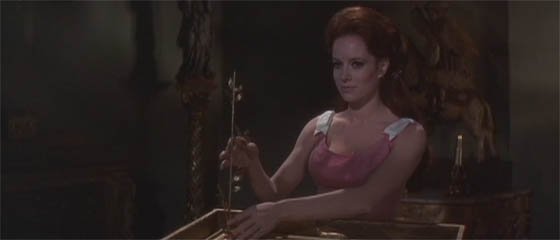 Leonard Maltin’s Movie Guide gives Captain Nemo and the Underwater City (1969) two-and-a-half stars and a fragment of a sentence. Until the Warner Archives recently released the film on DVD, I had hardly heard of it before; but upon learning that Italian actress Luciana Paluzzi co-starred, I quickly sought it out. You see, I can trace when I hit puberty: it was when I saw Thunderball (1965), in particular when Paluzzi, sitting in a bathtub, asks James Bond if she could have something to put on (he hands her slippers). Also: the scene when James Bond sucks on Domino’s foot. Look, we all have to start somewhere. In what’s otherwise a pretty slow-paced 007 outing, Paluzzi easily walks away with the film, portraying Fiona Volpe, one of Bond’s most dangerous femme fatales, and certainly the sexiest. Wearing her leather assassin’s outfit, she drives a motorcycle equipped with a rocket launcher. She’d rather sleep with Bond than kill him, but either way she’d enjoy herself. That mix of glamour, animal sexuality, and killer instinct is irresistible in her performance. Alas, in Captain Nemo and the Underwater City she’s not an assassin, but rather a demure swimming coach (it’s true) caught between two square-jawed men. Still, she’s showcased lovingly: she tends to a flock of children in her swimming class with motherly grace; she elegantly leaps from a diving board during an exhibition; she even plays a theremin (!) while being filmed in soft focus. Paluzzi fans, please congregate – this isn’t to be missed.
Leonard Maltin’s Movie Guide gives Captain Nemo and the Underwater City (1969) two-and-a-half stars and a fragment of a sentence. Until the Warner Archives recently released the film on DVD, I had hardly heard of it before; but upon learning that Italian actress Luciana Paluzzi co-starred, I quickly sought it out. You see, I can trace when I hit puberty: it was when I saw Thunderball (1965), in particular when Paluzzi, sitting in a bathtub, asks James Bond if she could have something to put on (he hands her slippers). Also: the scene when James Bond sucks on Domino’s foot. Look, we all have to start somewhere. In what’s otherwise a pretty slow-paced 007 outing, Paluzzi easily walks away with the film, portraying Fiona Volpe, one of Bond’s most dangerous femme fatales, and certainly the sexiest. Wearing her leather assassin’s outfit, she drives a motorcycle equipped with a rocket launcher. She’d rather sleep with Bond than kill him, but either way she’d enjoy herself. That mix of glamour, animal sexuality, and killer instinct is irresistible in her performance. Alas, in Captain Nemo and the Underwater City she’s not an assassin, but rather a demure swimming coach (it’s true) caught between two square-jawed men. Still, she’s showcased lovingly: she tends to a flock of children in her swimming class with motherly grace; she elegantly leaps from a diving board during an exhibition; she even plays a theremin (!) while being filmed in soft focus. Paluzzi fans, please congregate – this isn’t to be missed.
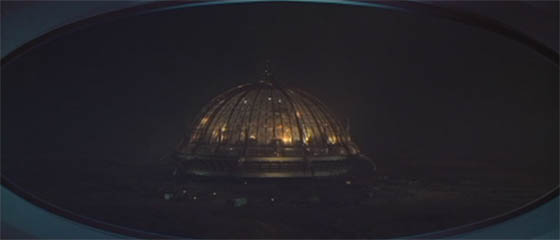 That all of this occurs in the 19th century world of Jules Verne may seem ridiculous, but suspend your disbelief, all ye who enter this film. This is, after all, the story of Captain Nemo (Robert Ryan) who rescues passengers from a sinking ship and transports them to his underwater colony, Templemere, a deep-sea Shangri-La that thrives upon inventions which can manufacture air, fresh water, and gold. So if you’re going to waste time ticking off every improbability, you’d best watch something else. (Anyway, to be generous, you could just call this steampunk. Because it does seem to have a steampunk aesthetic going on here.) Nemo is, in this outing, constructing his ideal Utopia beneath the waves, using his fabulous technology to meet every need of its hundreds of inhabitants, and hoping, in this manner, to outlive the humans on the surface, who threaten to annihilate all civilization with their endless wars. In other words, this is a Cold War film, and very much a post-Hiroshima reflection on the implication of weapons which can destroy the world; curiously, this film takes place before the atom was ever split, but Nemo cites that an explosion caused by his construction crew has mutated one of the mobula rays outside the city and caused it to grow to enormous size, Godzilla-style. Periodically it terrorizes the colony’s divers or Nemo’s famous Nautilus, which makes another welcome big-screen appearance.
That all of this occurs in the 19th century world of Jules Verne may seem ridiculous, but suspend your disbelief, all ye who enter this film. This is, after all, the story of Captain Nemo (Robert Ryan) who rescues passengers from a sinking ship and transports them to his underwater colony, Templemere, a deep-sea Shangri-La that thrives upon inventions which can manufacture air, fresh water, and gold. So if you’re going to waste time ticking off every improbability, you’d best watch something else. (Anyway, to be generous, you could just call this steampunk. Because it does seem to have a steampunk aesthetic going on here.) Nemo is, in this outing, constructing his ideal Utopia beneath the waves, using his fabulous technology to meet every need of its hundreds of inhabitants, and hoping, in this manner, to outlive the humans on the surface, who threaten to annihilate all civilization with their endless wars. In other words, this is a Cold War film, and very much a post-Hiroshima reflection on the implication of weapons which can destroy the world; curiously, this film takes place before the atom was ever split, but Nemo cites that an explosion caused by his construction crew has mutated one of the mobula rays outside the city and caused it to grow to enormous size, Godzilla-style. Periodically it terrorizes the colony’s divers or Nemo’s famous Nautilus, which makes another welcome big-screen appearance.
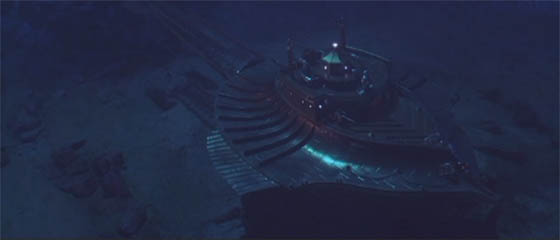 This was the third time Nemo’s submarine appeared on-screen, and naturally it’s a different design, now looking similar to a manta ray. Captain Nemo and the Underwater City followed Ray Harryhausen’s Mysterious Island (1961), and Walt Disney’s 20,000 Leagues Under the Sea (1954) before it, and fully expects that its audience will have seen at least one of those films, or, of course, read Jules Verne’s books. But it states its preference by casting Chuck Connors as the hero, Senator Robert Fraser; Connors bears a close physical likeness to Kirk Douglas of the Disney film. Similarly, two of his companions, the larcenous siblings Swallow and Barnaby, owe some slight lineage to Peter Lorre’s character in the original. And unlike Mysterious Island, this film takes place almost entirely underwater, in Nemo’s domain, spending plenty of time describing in Vernesian detail how a colony can thrive off the flora and fauna of the deeps. (Actually, if you were going to make these films a trilogy, you might want to stick this one in the middle. But I’d have to watch them all again to verify that makes some chronological sense.)
This was the third time Nemo’s submarine appeared on-screen, and naturally it’s a different design, now looking similar to a manta ray. Captain Nemo and the Underwater City followed Ray Harryhausen’s Mysterious Island (1961), and Walt Disney’s 20,000 Leagues Under the Sea (1954) before it, and fully expects that its audience will have seen at least one of those films, or, of course, read Jules Verne’s books. But it states its preference by casting Chuck Connors as the hero, Senator Robert Fraser; Connors bears a close physical likeness to Kirk Douglas of the Disney film. Similarly, two of his companions, the larcenous siblings Swallow and Barnaby, owe some slight lineage to Peter Lorre’s character in the original. And unlike Mysterious Island, this film takes place almost entirely underwater, in Nemo’s domain, spending plenty of time describing in Vernesian detail how a colony can thrive off the flora and fauna of the deeps. (Actually, if you were going to make these films a trilogy, you might want to stick this one in the middle. But I’d have to watch them all again to verify that makes some chronological sense.)
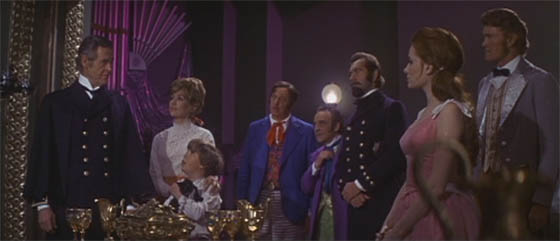 James Hill (Born Free) directs this time out, and does a respectable job, especially in his use of widescreen. But Robert Ryan – who starred in one of the best boxing films ever, The Set-Up (1949) – is unfortunately miscast as Captain Nemo. Granted, neither James Mason nor Herbert Lom lent Nemo the correct ethnicity (he’s from India), but they delivered gravitas; Ryan plays him as a grouchy, stern, and aging American, and it’s a hard sell. (Doubtless a big American star was sought to help market the film back in the States.) A solid supporting cast includes Nanette Newman (The Stepford Wives) as a pretty young mother who catches Nemo’s eye; Allan Cuthbertson (Performance) as a man driven to insanity by his claustrophobia; Paluzzi as the innocent but sensual Mala, who falls for Connors’ Senator Fraser; John Turner as Nemo’s second-in-command, the hand of the law until he’s finally undone by his unrequited love for Mala; and Bill Fraser (Up Pompeii) and Kenneth Connor (the Carry On films) as Barnaby and Swallow. Barnaby dresses like Captain Kangaroo, and Swallow like the Joker, so they pop out of every scene in bright primary colors. For a while, they’re also accompanied by overly “wacky” comic-relief music, which thankfully falls to the wayside as their characters grow more distinctive and interesting as the film progresses.
James Hill (Born Free) directs this time out, and does a respectable job, especially in his use of widescreen. But Robert Ryan – who starred in one of the best boxing films ever, The Set-Up (1949) – is unfortunately miscast as Captain Nemo. Granted, neither James Mason nor Herbert Lom lent Nemo the correct ethnicity (he’s from India), but they delivered gravitas; Ryan plays him as a grouchy, stern, and aging American, and it’s a hard sell. (Doubtless a big American star was sought to help market the film back in the States.) A solid supporting cast includes Nanette Newman (The Stepford Wives) as a pretty young mother who catches Nemo’s eye; Allan Cuthbertson (Performance) as a man driven to insanity by his claustrophobia; Paluzzi as the innocent but sensual Mala, who falls for Connors’ Senator Fraser; John Turner as Nemo’s second-in-command, the hand of the law until he’s finally undone by his unrequited love for Mala; and Bill Fraser (Up Pompeii) and Kenneth Connor (the Carry On films) as Barnaby and Swallow. Barnaby dresses like Captain Kangaroo, and Swallow like the Joker, so they pop out of every scene in bright primary colors. For a while, they’re also accompanied by overly “wacky” comic-relief music, which thankfully falls to the wayside as their characters grow more distinctive and interesting as the film progresses.
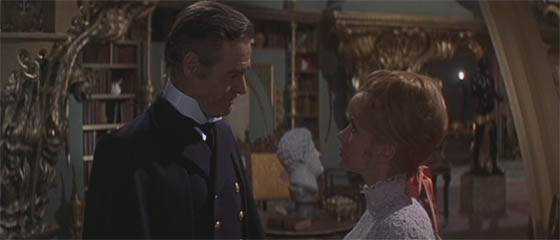 That’s the secret weapon of Captain Nemo and the Underwater City: the character development is understated but substantial, and you grow to care about these men and women – just as Nemo, gradually, learns to overcome his tyrannical impulses and form tentative relationships with them – before an escape plan is finally enacted, and Nemo reluctantly wages war against the escapees. Nemo, in many ways, is the film’s Prospero: an exile whose fearsome, unbending demeanor hiding a tenderness; which would make Mala his Miranda, falling in love with the first outsider she meets. This is a family matinee picture, but as an adult one can appreciate the moral ambiguities which the film refuses to resolve. The recurring question which the castaways ask of each other is whether they should stay, as Nemo demands, or escape; the allure of his Utopia is great, and really, there’s not much to dislike about Templemere. You get to sit poolside in a toga all day, while Nemo sees to your every need. Barnaby and Swallow hope to flee with a crate of stolen gold, until Swallow starts to have second thoughts: for him, to stay in the underwater city would be to chase contentment rather than greed. For Newman’s Helena, staying in Templemere offers a chance to rebuild family and home. But for Fraser, it’s a betrayal to his country; he needs to return to the United States since he’s carrying secret information which can prevent a war of vast destruction. He is willing to sacrifice his own happiness – a life with Mala – to save the lives of the people of the surface. There’s some meat in this screenplay, and it helps considerably…
That’s the secret weapon of Captain Nemo and the Underwater City: the character development is understated but substantial, and you grow to care about these men and women – just as Nemo, gradually, learns to overcome his tyrannical impulses and form tentative relationships with them – before an escape plan is finally enacted, and Nemo reluctantly wages war against the escapees. Nemo, in many ways, is the film’s Prospero: an exile whose fearsome, unbending demeanor hiding a tenderness; which would make Mala his Miranda, falling in love with the first outsider she meets. This is a family matinee picture, but as an adult one can appreciate the moral ambiguities which the film refuses to resolve. The recurring question which the castaways ask of each other is whether they should stay, as Nemo demands, or escape; the allure of his Utopia is great, and really, there’s not much to dislike about Templemere. You get to sit poolside in a toga all day, while Nemo sees to your every need. Barnaby and Swallow hope to flee with a crate of stolen gold, until Swallow starts to have second thoughts: for him, to stay in the underwater city would be to chase contentment rather than greed. For Newman’s Helena, staying in Templemere offers a chance to rebuild family and home. But for Fraser, it’s a betrayal to his country; he needs to return to the United States since he’s carrying secret information which can prevent a war of vast destruction. He is willing to sacrifice his own happiness – a life with Mala – to save the lives of the people of the surface. There’s some meat in this screenplay, and it helps considerably…
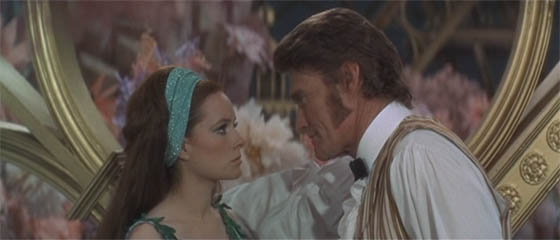 …because this film is, at times, terribly silly, from the alchemical devices which create too much gold for the colony to handle (they have a “scrap heap” filled with discarded items of gold), to the ringing alarms in the shapes of red lobsters, to the poorly-edited shark attack, to the Eloi-like, scantily-clad young women who hang about the pools, to the green “seaweed beer” they drink and, again, that scene in which Luciana Paluzzi plays the theremin, of all the instruments in the world. But some of the scale models are quite good, particularly the exterior shot of Templemere as the Nautilus first approaches, and the interior sets, where most of the action is staged, are beautifully designed. Later 70’s matinee fantasies, like anything starring Doug McClure, would look much cheaper, but Captain Nemo and the Underwater City is handsome and respectable. Leonard Maltin was at least half-a-star short. This one’s a pretty solid affair; and it does, I cannot understate, feature Fiona Volpe herself in a toga. Dubbed once more, but still.
…because this film is, at times, terribly silly, from the alchemical devices which create too much gold for the colony to handle (they have a “scrap heap” filled with discarded items of gold), to the ringing alarms in the shapes of red lobsters, to the poorly-edited shark attack, to the Eloi-like, scantily-clad young women who hang about the pools, to the green “seaweed beer” they drink and, again, that scene in which Luciana Paluzzi plays the theremin, of all the instruments in the world. But some of the scale models are quite good, particularly the exterior shot of Templemere as the Nautilus first approaches, and the interior sets, where most of the action is staged, are beautifully designed. Later 70’s matinee fantasies, like anything starring Doug McClure, would look much cheaper, but Captain Nemo and the Underwater City is handsome and respectable. Leonard Maltin was at least half-a-star short. This one’s a pretty solid affair; and it does, I cannot understate, feature Fiona Volpe herself in a toga. Dubbed once more, but still.









